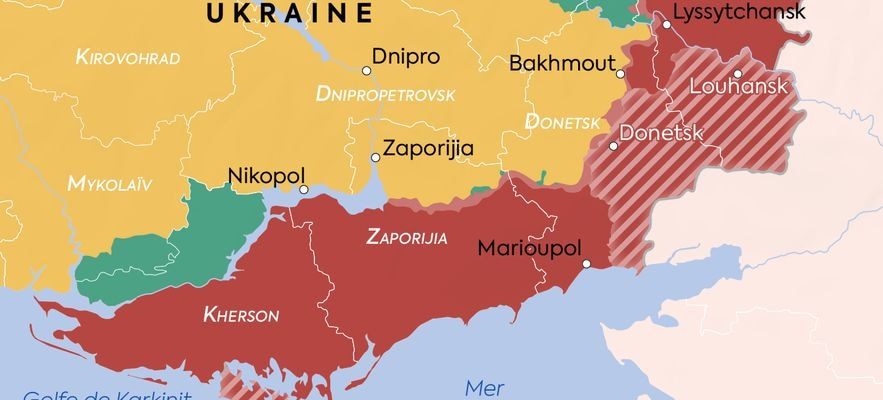With the Canjuers camp, north of the Var, France has one of the largest shooting ranges on the continent. In recent weeks, in the middle of its arid hills where snakes live on the lookout and dry shrubs, it has trained Ukrainian soldiers in the handling of the AMX-10 RC. Several videos, shared on social networks, showed some of them, thumbs up or making the V for victory, at the controls of the “light combat tank” promised at the start of the year by Emmanuel Macron to his Ukrainian counterpart, Volodymyr Zelensky.
Received in mid-March, these tanks equipped with a 105 mm gun could participate in the counter-offensive prepared for months by Kiev strategists. The latter no longer hide their intentions, while the Russians are struggling to take the city of Bakhmout, in the Donbass, where the losses are accumulating. “Very soon we will take advantage of this opportunity, as we did in the past near Kiev, Kharkiv, Balaklya and Kupyansk,” said Ukrainian ground forces commander Oleksandr Syrsky, citing military victories since the invasion of February 24, 2022.
For President Zelensky and his generals, regaining the initiative is not an option, but a necessity. “They find themselves in the same position as the French during the First World War, their territory is occupied, to drive out the Russian aggressor, they must regain the initiative, underlines Mark Cancian, principal adviser of the Center for Strategic and International Studies ( CSIS), based in Washington. Progress would also allow them to show Americans and Europeans that the war can be won and will not last forever.”
More than ever, the Ukrainian army depends on the support provided by NATO member countries. These multiplied the promises of ever heavier weapons and even provided it with combat planes – Mig-29s from which Poland and Slovakia separated. The AMX-10 RCs aren’t the only Western-built armor the Ukrainians are currently training on. Other videos showed some piloting, in Germany, American armored infantry Stryker and Bradley, the latter having a 25 mm automatic cannon and a formidable anti-tank missile system.
Ukraine is preparing for a counter-offensive.
© / Legends Cartography
The training provided by the West no longer only concerns the appropriation of specialized equipment, such as the American Himars multiple rocket launchers, the French Caesar self-supporting guns or the German Leopard 2 tanks. “We first trained the Ukrainians to defensive battles to absorb the shock of the invasion; for the reconquest, they now train in combined arms combat, where it is a question of effectively combining infantry, cavalry, artillery and engineer units” , explains Yohann Michel, researcher on defense issues at the International Institute for Strategic Studies (IISS).
On the side of the Twenty-Seven, these tactical apprenticeships are coordinated by the staff of the European Union, whose objective of training Ukrainian soldiers doubled, at the beginning of February, to be increased to 30,000 men. They concern battalions of several hundred people called to participate in the next offensives. These collective training sessions complement those carried out on Ukrainian soil. “The national mobilization continues month after month, notes the historian of the war Michel Goya, former colonel of the navy troops. We know that Kiev trains behind the front 19 brigades corresponding to approximately 50,000 men.”
Reinforced Russian defenses
Kiev is therefore far from having concentrated its forces in the Donbass, in particular in the Bakhmout area, where the bloodiest fighting in recent months has taken place – in total, at least 120,000 Ukrainian fighters have been killed or injured since the invasion. , more than 200,000 on the Russian side, according to Westerners. “Soldiers in the trenches forgive me, it’s more important right now to focus on hoarding resources for the longer, heavier battles that may begin next year,” he warned in December. Ukrainian Chief of Staff, Valery Zalouzhny. Weather drying out the soil in the coming weeks could favor the transition from a defensive posture to offensive operations.
The Russians are preparing for it. Their withdrawals from part of the Kharkiv and Kherson regions enabled them to tighten their lines, to concentrate more soldiers there than before and to fortify them. “The first weeks of a Ukrainian counter-offensive promise to be complicated, especially since it is less expensive to defend than to attack, points out Mark Cancian. But if the combined arms maneuvers work well, it will no doubt be possible to find weak points, because the Russians cannot be strong everywhere. If they manage to break through, the Ukrainians will have the advantage over an overwhelmed adversary, who will no longer be able to remain in a defensive position in their trenches.”
Along the entire length of the front, two zones seem less favorable to a counter-offensive: that of Donetsk, one of the most fortified in the world since the secession of part of the Donbass, and that of Kherson, separated by a natural barrier. , the Dnieper River. So there remains the line of Luhansk, to the northeast, and that of the oblast of Zaporijia, to the southeast, where a Ukrainian breakthrough would make it possible to reach the Black Sea and cut in two the territory occupied by the Russians. To the chagrin of Moscow, Crimea, annexed in 2014, would therefore only be accessible by the Kerch bridge.
While arguing that “the next Ukrainian offensive will be strategically critical and potentially decisive”, Rob Lee, a researcher at the American Foreign Policy Research Institute, believes in an analysis published on Twitter that “Western aid, including ammunition”, due to the depletion of stocks, “will probably peak this spring and summer” and that it “will be years before the increase in the production capacity of artillery can make its effects felt”. Should their counter-offensive fail, kyiv’s strategists would not soon have the opportunity to catch up.
